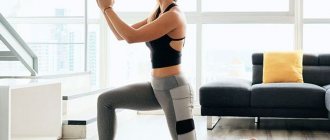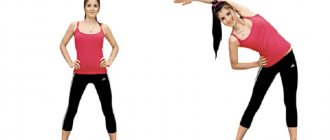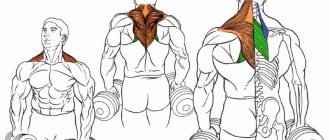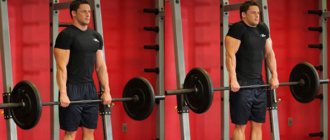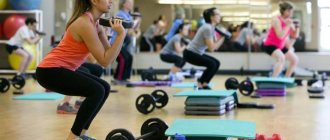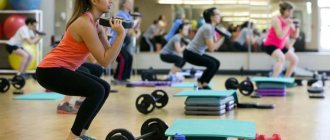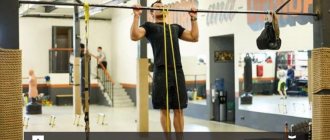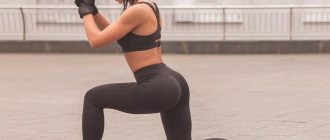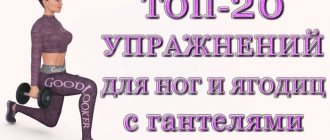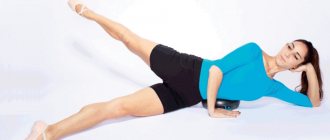This exercise is very simple, it can be done using a simple cabinet or chair, and yet it provides an excellent workout for the muscles of the whole body and promotes weight loss and weight loss.
Stepping onto a bench with dumbbells for the buttocks is included in many training complexes, as it is one of the most effective for working out the muscles of the thighs and buttocks.
The results will largely depend on the regularity of training, since several missed workouts can only be made up by having to start all over again.
What muscles work in the exercise
Stepping onto a bench is a multi-joint, or as they are also called, basic exercises for the legs and buttocks.
As befits a basic movement, a large number of muscles are involved here.
Let's look at what muscles work when doing:
- Quadriceps
- Biceps hamstrings
- Gluteus muscle
This is considered to be an excellent exercise for developing the buttocks, which is as effective as glute bridges or lunges.
The range of motion involves these muscles to the maximum.
- Inner and outer thigh (depending on version)
- Calf
The lumbar muscles and abs act as stabilizers.
Very often the exercise is done with additional weights in the form of dumbbells, kettlebells or a barbell disc.
Then it becomes even more complex, because in this case the muscles of the shoulder girdle are additionally loaded - shoulders, biceps and forearms.
But that's not all!
This is a fairly fast movement that trains not only strength and muscle size, but also endurance, increasing the vital capacity of the lungs.
Tips for maximum efficiency
- Before you start training, you need to do a short WARM-UP. Pay special attention to the knee and hip joints.
- Step-ups are less effective than heavy compound exercises, so they are best left for the end of the workout. With their help, you can squeeze all the juice out of your quadriceps.
- Before you pick up dumbbells, work out the exercise technique well. It is its assimilation that will make your workout more productive.
- If you find it difficult to hold dumbbells in your hands for a long time, then use wrist straps. They will take the pressure off your forearms.
I think this article helped you look at walking with dumbbells from a different perspective. Now all that remains is the simplest step to test them yourself in practice. If you don’t manage to do everything technically correctly the first time, then this is not a reason to stop. On the contrary, it is constant practice that will bring you closer to perfection and the muscles will be forced to grow.
Good luck to everyone in your training!
How to do the exercise correctly
Steps onto the platform are performed in different variations. But regardless of the technique, there are a number of typical errors that cause injuries or reduced efficiency.
Rounding the back
With a rounded back, the muscle corset does its job worse.
As a result, when performing the exercise, the compression load on the spine increases.
It is not as critical as, for example, during incorrect back position when doing squats or deadlifts. But still noticeable.
If there is an opportunity to minimize the risk of injury, use it.
Before starting the movement, straighten your back, moving your shoulders back, and squeeze your shoulder blades together.
As for the strong forward tilt of the torso (especially when lifting up), this movement technique transfers part of the load to the lumbar muscles.
As a result, the effect on target muscle groups is reduced.
Help from the other leg
The working leg in this exercise is the one that is placed on the stand. Due to this, the upward movement is carried out.
If you push with the leg that is on the floor, the load is distributed between the two legs, and the impact on the necessary muscles is reduced. The calf muscle of the non-working leg is actively involved in the movement.
The exercise in this version loses its meaning.
If walking is so difficult that you have to use the help of the other leg, reduce the weight of the burden or lower the height of the support.
Rotate the knee inwards
From the point of view of physiology and biomechanics of movement, the most natural position of the foot is when the knee and toe are in the same projection, that is, directed in the same direction.
If the knee is turned outward or, more often, inward, then severe tension arises in the knee joint itself and in its lateral ligaments.
If you make this mistake 1-2 times, nothing bad will happen. But if you do this on a regular basis, sooner or later problems with your knees are guaranteed.
Pay attention to the position of your foot on the platform. Always point your knee and toe in the same direction.
Positioning the leg until it is fully straightened
Some people consider not straightening the leg at the knee joint a mistake. Others, on the contrary, say that full straightening is incorrect and dangerous.
Both statements are controversial and have arguments for and against.
A noticeable lack of straightening in the knee is considered a serious mistake. In this case, the exercise is performed at half the lower amplitude.
However, a common walking technique is that in the upper phase of the movement the leg at the knee is not completely straightened, leaving it slightly bent.
This feature helps maintain constant tension in the muscles being worked.
It is also believed that with this design, the knee joints wear out less. True, this statement is more suitable for professional athletes who work with maximum weight.
Adherents of the classical technique of stepping onto a pedestal consider it more correct to perform the exercise in full amplitude, with full straightening of the knee.
They also have an argument - this is the only way the muscle works along its entire length . This means it receives maximum load.
We recommend trying both options, and muscle sensations will accurately tell you which one is most suitable for you.
Common mistakes
There are quite a lot of methods on how to pump up your buttocks, but not all of them give such an effective result as doing step-ups. And although coaches point out the importance of correct execution, common mistakes still happen. When the knee of the working leg begins to extend beyond the toe, the body position looks unnatural and the load on the joint increases. If you apply the wrong pressure, you can seriously damage your leg.
When the back is rounded, the entire load, instead of the selected muscle groups, begins to fall on the spine, which can cause unpleasant pain. Experts advise keeping your back straight in all exercises.
When it becomes difficult to do the exercise, people begin to help themselves by leaning forward. In this case, it is difficult to concentrate and distribute your weight evenly on both legs. The entire load should fall on the target muscle group, and not on the body.
Avoiding these mistakes will help you correctly perform steps onto a stand with dumbbells and achieve maximum results. If performing an exercise with weights is difficult, you can do several approaches without weights.
Shifting the load on different muscles
The main type of stepping onto a platform is while standing facing the platform .
All repetitions are done either on one leg at once, or with each repetition the legs are alternated.
Here there is an almost uniform distribution of the load on the front, back of the thigh and gluteal muscles.
There are also other types of technology. It is believed that different starting positions and subsequent types of movements shift the emphasis to certain parts of the legs and buttocks.
Lateral or lateral steps
Starting position - standing sideways to a box or bench.
They rise to the dais with the leg that is closest to the platform.
It is more convenient to do it completely on one leg and only then move on to the second. But there are options for stepping over the box and performing the movement on the other leg, with further alternation. So the energy consumption of movement increases.
When walking sideways, the outer part of the thigh is additionally loaded.
Diagonally
In this version, a person stands facing the cabinet, near one of the corners, and climbs onto it, taking a step towards the opposite edge diagonally.
This type of technique is believed to activate the inner thighs and quadriceps.
Cross-shaped
The starting position is the same as for lateral steps.
But you should step onto the pedestal with the foot that is further away. That is, if you stand with your left side towards a hill, then you step onto it with your right foot.
This technique focuses the load on the gluteal muscles.
Performance technique
To properly work the necessary muscle groups, you should perform the exercise correctly. The technique involves the following algorithm:
- Place the platform at knee level.
- Stand 15-30 cm from the platform. The specific distance depends on the individual characteristics of the body.
- Place your feet hip-width apart and bend your knees slightly.
- Tightening your stomach, bend slightly at the lower back.
- You need to hold dumbbells at your sides.
- As you inhale, move the center of gravity to one leg, and step onto the platform with the other (which is called the working leg).
- Straining the thigh muscles of the working leg, transfer the weight to its foot.
- Pushing off the floor with your second foot, place it on the platform next to your working leg. Exhale.
- Inhale and step back. The working leg should remain on the platform. This series of actions counts as one repetition.
The exercises should be performed by changing the working leg. You can do this every other time or perform a series of repetitions and only then make a replacement.
The correct technique for performing the exercise is discussed in this video:
Other ways to do it
The variability of traditional steps facing the stand is limited only by the athlete’s imagination.
Among these methods:
- Knee lift at the top point
Rising onto the stand, the knee of the free leg rises up towards the chest.
Such a movement additionally engages the muscles of the second leg, without removing the load from the target muscles. And this increases energy costs.
- Leg abduction at the top point
In the upper phase of the movement, the free straight leg is moved back (the amplitude of the movement is small).
This variety helps to additionally load the back of the thigh and buttocks.
- With a lunge
A very energy-intensive exercise, as it combines two complex movements - steps and lunges.
First, do a classic rise up, and when you come down, lunge back.
The exercise is suitable for well-physically trained people.
High step lunges with barbell [edit]
Inventory
: step, barbell.
Core muscles
: quadriceps.
Additional muscles
: buttocks, hamstrings, lower back.
Level of training
: elementary, intermediate.
Step 1
. Place the barbell on your shoulders as you would for a regular barbell squat. Place your left leg on a high step, bending it at the knee at a right angle.
Step 2
. Push up, rising up and straightening your left leg.
Step 3
. Return to starting position and repeat. Keep your back straight throughout the entire movement.
Inclusion in the training program
The exercise can be added to the training of both men and women.
The first use it when training quadriceps, as a secondary basic movement.
Climbing onto a pedestal will fit into a multi-repetition leg training regime, as an exercise of a “finishing” nature.
It is placed both in the middle and at the end of the program on the hips, after performing the base with heavy weight.
The weight of the weights when stepping is moderate, but the number of repetitions is high - 12-20 times on each leg.
Women are more likely and more willing to include them in training programs. Depending on what is being worked on during the training - thighs or buttocks - the option of walking is selected.
Girls also use the exercise as a main exercise. As a rule, light and medium weights are used, as well as a high repetition regime - up to 15-25 times on each leg.
How are the basic steps useful?
Regular Basic Step exercises qualitatively strengthen the muscles of the lower body and develop a muscle group that stabilizes the pelvis, hips and spine.
Each person chooses for himself why he needs training with basic steps. The number of approaches and repetitions depends on the goals, level of physical fitness, and equipment. A personal training program may include a set of auxiliary exercises and a break schedule.
Basic steps help:
- Make the body strong, resilient, fit.
- Build muscle mass.
- Get rid of extra pounds - Basic Step is especially effective in combination with a balanced diet and other physical activity.
- Tone the muscles, work out the silhouette of the figure.
When to Use Extra Weight
The weight and type of weights are determined based on training goals.
Most girls, for example, work out to lose weight . This means more repetitions and less rest time between sets.
In most of these cases, stepping is performed with your own weight. In this case, a platform with a comfortable height is selected. If the exercise is easy, increase the height of the stand.
However, athletes with a high level of training also use additional weights - weights for the legs or arms, dumbbells, a kettlebell, a barbell disc (these implements are held in the hands), as well as a light barbell on the shoulders.
If training is carried out to increase the muscle volume of the thighs and buttocks, the use of additional weights of moderate weight is mandatory.
The repetition range is reduced to 10-15 times on each leg.
Correct technique
- Take dumbbells in your hands. For female beginners, 3-5 kg is suitable, for male beginners - 7-10.
- Straighten up, squeeze your shoulder blades together, slightly arch your back, stand in front of a bench (platform, etc.)
- Place your working leg on the bench with your full or almost full foot.
- Raise your other leg towards your working leg. You can place it next to it on the bench, but it is better not to do this - when the knee joint straightens to the end, this increases the load on it, maintain a small angle in the working leg.
- Lower your non-working leg back to the floor.
Correct technique for men:
Read also: Chocolate cupcake with custard
And for women:
Contraindications to exercise
Walking is a complex coordination exercise, even if performed without additional weights. And when rising to the maximum permissible height, the intensity reaches its maximum values.
Therefore, there are a number of contraindications for implementation:
- Serious diseases of the cardiovascular system
- Tendency to high blood pressure
- Diseases of joints and ligaments (ankle, knee and hip)
- Poor coordination and vestibular apparatus
